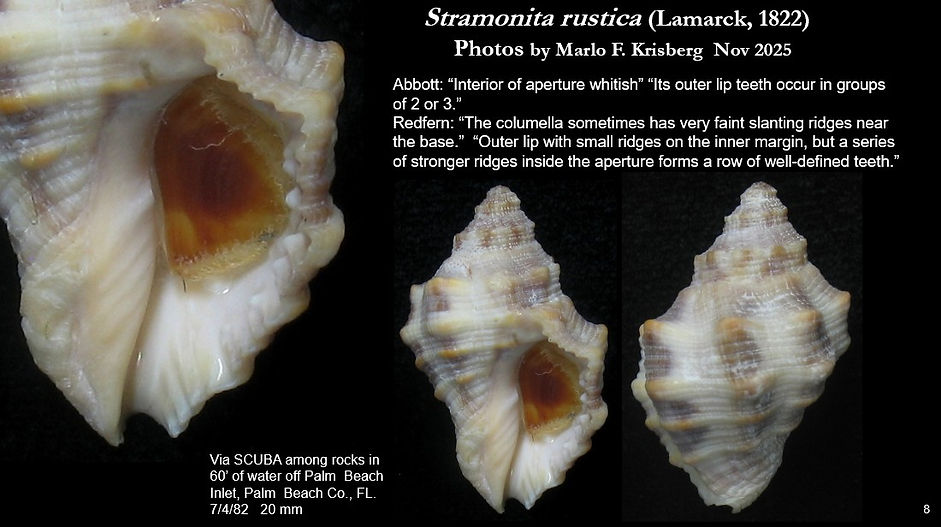WoRMS currently (Nov 2025) recognizes ten species of Stramonita. One (S. buchecki) is unlikely to be a valid species. Six have distributions that do not include Florida. One of the six (S. haemastoma) was long, and still is in many publications and online sites, considered to be the comprehensive species name for a complex of species occurring in Europe and the western Atlantic. However, based upon several molecular studies WoRMS has replaced the species named S. haemastoma for the Stramonita found in Florida waters with three species elevated from subspecies status to full species status; S. canaliculata, S. floridana, and S. rustica.
An influential paper regarding this change that also addresses the distribution of Stramonita in Florida was published in 2011:
Ref: Claremont, M., Williams, S. T., Barraclough, T. G., and Reid, D. G. 2011. The geographic scale of speciation in a marine snail with high dispersal potential. Journal of Biogeography U. Biogeogr. 38: 1016-1032.
Referenced paper utilized the Stramonita haemastoma complex of shells to investigate the geographic scale of speciation in a marine snail with a long open ocean larval stage. Although not specifically focused on a comprehensive analysis to ascertain morphological and genetic speciation within the complex, the study utilized a combination of molecular and morphological methods to establish geographical ranges and reconstruct phylogenetic relationships. As a result, the authors found support for six species within the Stramonita haemastoma complex. Although
S. rustica was validated as a species having a wide range, the authors’ molecular analysis of Stramonita samples from Florida did not find any to be S. rustica. Based upon this aspect of the paper many subsequent authors (including earlier presentations of Stramonita on LTS) indicated that S. rustica does not occur in Florida. However, a close reexamination of the paper finds that the population for the DNA sequencing portion of the analysis included only seven lots from Florida [two from NW Florida (all were S. canaliculata) and five from NE Florida (all were S. floridana)]. So, no S. rustica were identified in Florida from the DNA sequencing portion of the analysis. The paper combined the molecular data with an examination of literature and specimens from the Natural History Museum, London (BMNH) collection to create species distribution maps. One BMNH specimen of S. rustica is indicated in the maps (Fig. 1) from SE Florida. Only a very, very close examination of the maps reveals this one finding. I, and I suspect many others,, missed this tidbit of information (not discussed in the text in the paper), and without it, concluded that S. rustica did not occur in Florida. I became aware of it only recently (11/8/25) in an email from one of the paper’s authors (David Reid) directing me to the maps. To check this finding I searched the BMNH collection, but did not find it.
So, the conclusion that S. rustica is not present in Florida is rather shaky since the DNA sequencing portion of the analysis did not include samples from SE Florida, the Florida Keys, or the Bahamas where S. rustica has been reported. Both Abbott (1974) and Rehder (1981) report S. rustica from “Southeast Florida to Brazil.” Redfern (2001) also reports it in the Bahamas. Therefore, based on the above circumstances, and a reexamination of my samples of Stramonita from SE Florida and the Florida Keys, I now consider S. rustica present in Florida.




















